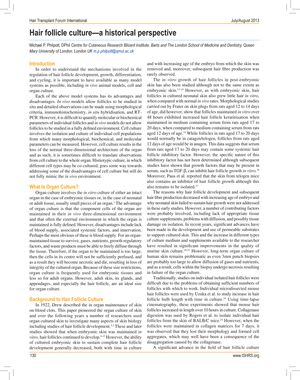TLDR Advancements in hair follicle culture have led to better understanding and potential treatments for hair loss.
The document provided a historical overview of hair follicle culture, focusing on the advancements in understanding the mechanisms regulating hair follicle growth and development. It highlighted key milestones in the field, including the development of in vitro culture techniques that allowed for the detailed study of hair follicle biology. These techniques enabled researchers to investigate the effects of various factors on hair growth, shedding light on the complex interactions between genetic, hormonal, and environmental influences. The review underscored the importance of these studies in paving the way for potential therapeutic approaches to treat hair loss and other hair-related disorders.
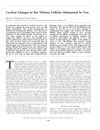 34 citations
,
December 2000 in “The journal of investigative dermatology/Journal of investigative dermatology”
34 citations
,
December 2000 in “The journal of investigative dermatology/Journal of investigative dermatology” Rat vibrissa follicles are useful for studying hair growth cycles, especially the transition from pro-anagen to anagen.
50 citations
,
September 1997 in “Developmental Biology”  17 citations
,
January 1997 in “Cell and Tissue Research”
17 citations
,
January 1997 in “Cell and Tissue Research” Scientists developed a method to grow human fetal skin and digits in a lab for 3-4 weeks, which could help study skin features and understand genetic interactions in tissue formation.
36 citations
,
October 1993 in “British Journal of Dermatology” Human hair follicles can grow in a lab for at least 9 days without serum, keeping their natural characteristics.
27 citations
,
January 1993 in “Archives of Dermatological Research” Hair follicles can grow and increase DNA synthesis in a serum-free environment, and minoxidil sulphate boosts this process.
385 citations
,
November 1990 in “Journal of Cell Science” Human hair follicles can grow in a lab setting.
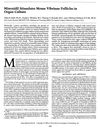 121 citations
,
March 1989 in “Journal of Investigative Dermatology”
121 citations
,
March 1989 in “Journal of Investigative Dermatology” Minoxidil can help grow hair in mice by making cells grow and improving hair quality. More research needed.
87 citations
,
October 1987 in “Journal of Investigative Dermatology” 34 citations
,
January 1983 in “Journal of Investigative Dermatology” 38 citations
,
August 1973 in “Journal of Investigative Dermatology”
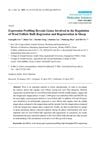 19 citations
,
April 2015 in “International Journal of Molecular Sciences”
19 citations
,
April 2015 in “International Journal of Molecular Sciences” The research identified genes and pathways important for sheep wool growth and shedding.
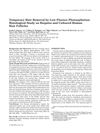 134 citations
,
September 2008 in “Lasers in surgery and medicine”
134 citations
,
September 2008 in “Lasers in surgery and medicine” Low fluence photoepilation temporarily removes hair by targeting the hair follicle's pigmented area without severe damage.
